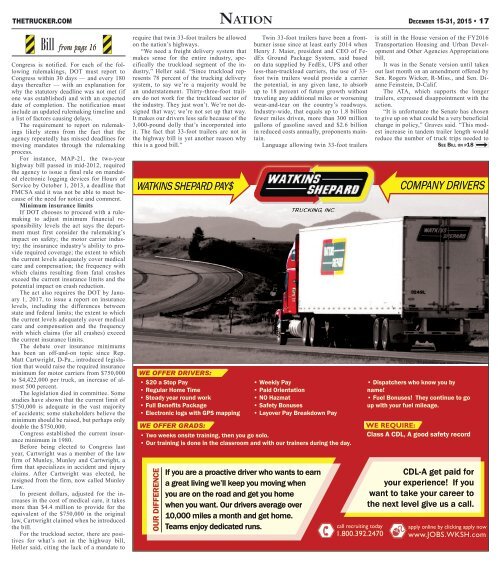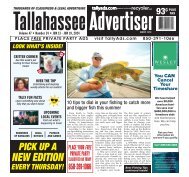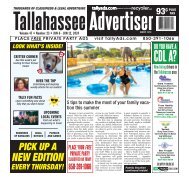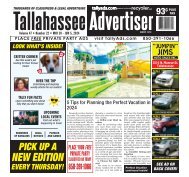You also want an ePaper? Increase the reach of your titles
YUMPU automatically turns print PDFs into web optimized ePapers that Google loves.
<strong>The</strong>trucker.com<br />
b Bill from page 16 b<br />
Congress is notified. For each of the following<br />
rulemakings, DOT must report to<br />
Congress within 30 days — and every 180<br />
days thereafter — with an explanation for<br />
why the statutory deadline was not met (if<br />
one was established) and with an expected<br />
date of completion. <strong>The</strong> notification must<br />
include an updated rulemaking timeline and<br />
a list of factors causing delays.<br />
<strong>The</strong> requirement to report on rulemakings<br />
likely stems from the fact that the<br />
agency repeatedly has missed deadlines for<br />
moving mandates through the rulemaking<br />
process.<br />
For instance, MAP-21, the two-year<br />
highway bill passed in mid-2012, required<br />
the agency to issue a final rule on mandated<br />
electronic logging devices for Hours of<br />
Service by October 1, 2013, a deadline that<br />
FMCSA said it was not be able to meet because<br />
of the need for notice and comment.<br />
Minimum insurance limits<br />
If DOT chooses to proceed with a rulemaking<br />
to adjust minimum financial responsibility<br />
levels the act says the department<br />
must first consider the rulemaking’s<br />
impact on safety; the motor carrier industry;<br />
the insurance industry’s ability to provide<br />
required coverage; the extent to which<br />
the current levels adequately cover medical<br />
care and compensation; the frequency with<br />
which claims resulting from fatal crashes<br />
exceed the current insurance limits and the<br />
potential impact on crash reduction.<br />
<strong>The</strong> act also requires the DOT by January<br />
1, 2017, to issue a report on insurance<br />
levels, including the differences between<br />
state and federal limits; the extent to which<br />
the current levels adequately cover medical<br />
care and compensation and the frequency<br />
with which claims (for all crashes) exceed<br />
the current insurance limits.<br />
<strong>The</strong> debate over insurance minimums<br />
has been an off-and-on topic since Rep.<br />
Matt Cartwright, D-Pa., introduced legislation<br />
that would raise the required insurance<br />
minimum for motor carriers from $750,000<br />
to $4,422,000 per truck, an increase of almost<br />
500 percent.<br />
<strong>The</strong> legislation died in committee. Some<br />
studies have shown that the current limit of<br />
$750,000 is adequate in the vast majority<br />
of accidents; some stakeholders believe the<br />
minimum should be raised, but perhaps only<br />
double the $750,000.<br />
Congress established the current insurance<br />
minimum in 1980.<br />
Before being elected to Congress last<br />
year, Cartwright was a member of the law<br />
firm of Munley, Munley and Cartwright, a<br />
firm that specializes in accident and injury<br />
claims. After Cartwright was elected, he<br />
resigned from the firm, now called Munley<br />
Law.<br />
In present dollars, adjusted for the increases<br />
in the cost of medical care, it takes<br />
more than $4.4 million to provide for the<br />
equivalent of the $750,000 in the original<br />
law, Cartwright claimed when he introduced<br />
the bill.<br />
For the truckload sector, there are positives<br />
for what’s not in the highway bill,<br />
Heller said, citing the lack of a mandate to<br />
require that twin 33-foot trailers be allowed<br />
on the nation’s highways.<br />
“We need a freight delivery system that<br />
makes sense for the entire industry, specifically<br />
the truckload segment of the industry,”<br />
Heller said. “Since truckload represents<br />
78 percent of the trucking delivery<br />
system, to say we’re a majority would be<br />
an understatement. Thirty-three-foot trailers<br />
do not work for the truckload sector of<br />
the industry. <strong>The</strong>y just won’t. We’re not designed<br />
that way; we’re not set up that way.<br />
It makes our drivers less safe because of the<br />
3,000-pound dolly that’s incorporated into<br />
it. <strong>The</strong> fact that 33-foot trailers are not in<br />
the highway bill is yet another reason why<br />
this is a good bill.”<br />
WAtkINS ShEPARD PAY$<br />
WE OFFER dRIVERS:<br />
• $20 a Stop Pay<br />
• Regular Home Time<br />
• Steady year round work<br />
• Full Benefits Package<br />
• Electronic logs with GPS mapping<br />
WE OFFER gRadS:<br />
OUR DIFFERENCE<br />
Nation <strong>December</strong> <strong>15</strong>-<strong>31</strong>, 20<strong>15</strong> • 17<br />
Twin 33-foot trailers have been a frontburner<br />
issue since at least early 2014 when<br />
Henry J. Maier, president and CEO of FedEx<br />
Ground Package System, said based<br />
on data supplied by FedEx, UPS and other<br />
less-than-truckload carriers, the use of 33-<br />
foot twin trailers would provide a carrier<br />
the potential, in any given lane, to absorb<br />
up to 18 percent of future growth without<br />
traveling any additional miles or worsening<br />
wear-and-tear on the country’s roadways.<br />
Industry-wide, that equals up to 1.8 billion<br />
fewer miles driven, more than 300 million<br />
gallons of gasoline saved and $2.6 billion<br />
in reduced costs annually, proponents maintain.<br />
Language allowing twin 33-foot trailers<br />
• Weekly Pay<br />
• Paid Orientation<br />
• NO Hazmat<br />
• Safety Bonuses<br />
• Layover Pay Breakdown Pay<br />
• Two weeks onsite training, then you go solo.<br />
• Our training is done in the classroom and with our trainers during the day.<br />
If you are a proactive driver who wants to earn<br />
a great living we’ll keep you moving when<br />
you are on the road and get you home<br />
when you want Our drivers average over<br />
10,000 miles a month and get home.<br />
Teams enjoy dedicated runs.<br />
call recruiting today<br />
1.800.548.8895<br />
call recruiting today<br />
1.800.392.2470<br />
is still in the House version of the FY2016<br />
Transportation Housing and Urban Development<br />
and Other Agencies Appropriations<br />
bill.<br />
It was in the Senate version until taken<br />
out last month on an amendment offered by<br />
Sen. Rogers Wicker, R-Miss., and Sen. Dianne<br />
Feinstein, D-Calif.<br />
<strong>The</strong> ATA, which supports the longer<br />
trailers, expressed disappointment with the<br />
action.<br />
“It is unfortunate the Senate has chosen<br />
to give up on what could be a very beneficial<br />
change in policy,” Graves said. “This modest<br />
increase in tandem trailer length would<br />
reduce the number of truck trips needed to<br />
See Bill on p18 m<br />
COMPANY DRIVERS<br />
apply online by clicking apply now<br />
www.JOBS.WKSH.com<br />
• Dispatchers who know you by<br />
name!<br />
• Fuel Bonuses! <strong>The</strong>y continue to go<br />
up with your fuel mileage.<br />
We RequiRe:<br />
Class A CDL, A good safety record<br />
CDL-A get paid for<br />
your experience! If you<br />
want to take your career to<br />
the next level give us a call.<br />
apply online by clicking apply now<br />
www.JOBS.WKSH.com

















